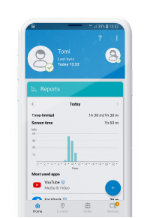It’s a fact of life that your child will likely experience name calling, get into arguments and perhaps face pressure to bully someone else online. From an early age, your child should be educated about how to handle these experiences. Let them know that you’re there to listen and encourage them to role play about how to handle different situations with you. Establishing trust and open communication from the earliest age will provide a good foundation for the future.
That said, here are signals that may indicate that your child is a victim of digital bullies:
Visible physical changes
Has your child suddenly lost weight or appetite? Do they have trouble sleeping during the night and look stressed out in the morning? These symptoms can have a variety of causes, but if combined with some of the points mentioned below, there’s a good chance that your child is being bullied, either online or in person.
Sudden loss of interest
Did your child love football or playing guitar, but suddenly lost all interest? This, in combination with other factors, can also be a sign that somebody is giving them a hard time, either online or in person.
Nervousness, sudden mood changes and short answers
Frequent moods swings don’t necessarily mean that your child is being harassed by a bully. However, if these are accompanied by terse responses or jumpy and nervous reactions—especially after using social media—it’s time to ask if they are having trouble.
This isn’t the time to be satisfied with responses such as “good” or “fine,” as these don’t always mean everything is good and fine. You’ll need to dig deeper to figure out how your child really feels about their experiences online.
Pretending to be sick to avoid school
“I don’t feel so good. Can I skip school today?” Almost every child uses excuses like these from time to time. Whether it’s an exam they didn’t prepare for or a sport they don’t enjoy, it’s common to avoid whatever is causing distress. However, if your child pretends to be ill too often, or for a prolonged period, there might a more serious issue at hand—such as fear of an inevitable conflict with a bully.
Deleted social network profile
If your child suddenly quits their favorite social networks, be wary. In an age where young people invest a lot of time building their digital life, deleting an account should set off an alarm. Parental control tools, installed on a child’s device, can give parents a good overview of which apps they use and help identify any sudden changes in that usage.
Abnormal social withdrawal
It’s only natural for teenagers to want to become more independent from their parents. This often involves devoting more time to building their own social networks. However, if they start to distance themselves from friends as well as family, lose interest in the outside world, and avoid social media, something is probably amiss.
In conclusion
Becoming an adult is a complicated journey, and kids and teenagers often show some of the above-mentioned signs even if they don’t have to cope with cyberbullies. However, parents (and teachers) should be wary if these symptoms start to pile up.
Be ready to offer support and a helping hand. If a child is displaying these signs, it is worth sitting down and asking them whether they feel that they are being targeted by bullies online. It is important to make sure that they know that they can confide in you without feeling threatened or judged, and that you are there to help them resolve the issues that they are experiencing.
Once you know what the issue is, you can then give clear advice on how to solve it. The first step is to demonstrate how to deal with a digital bully, for example by using the block and report features that are provided by social networks and online platforms.
It’s important to teach kids of all ages that in a bullying situation, it may be impossible to change someone else’s behavior, but we can control how we react.
You can use a non-confrontational approach when talking to your child about this by discussing incidents that happened to other people, such as your friends or their children. Be sure to mention how they succeeded in resolving an issue, for example, contacting school authorities about a bully or blocking someone on social media.
Using these stories as an analogy to what you suspect might be happening to your child can help them to open up—and to know they’re not alone.


